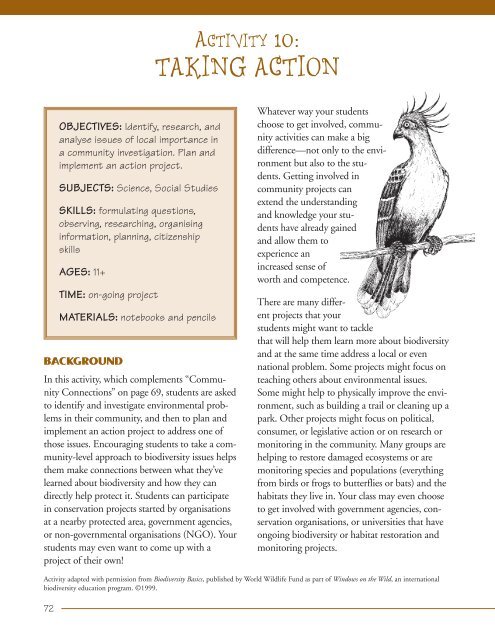EXPLORING BIODIVERSITY: A Guide for Educators Around the World
EXPLORING BIODIVERSITY: A Guide for Educators Around the World
EXPLORING BIODIVERSITY: A Guide for Educators Around the World
Create successful ePaper yourself
Turn your PDF publications into a flip-book with our unique Google optimized e-Paper software.
ACTIVITY 10:<br />
TAKING ACTION<br />
OBJECTIVES: Identify, research, and<br />
analyse issues of local importance in<br />
a community investigation. Plan and<br />
implement an action project.<br />
SUBJECTS: Science, Social Studies<br />
SKILLS: <strong>for</strong>mulating questions,<br />
observing, researching, organising<br />
in<strong>for</strong>mation, planning, citizenship<br />
skills<br />
AGES: 11+<br />
TIME: on-going project<br />
MATERIALS: notebooks and pencils<br />
BACKGROUND<br />
In this activity, which complements “Community<br />
Connections” on page 69, students are asked<br />
to identify and investigate environmental problems<br />
in <strong>the</strong>ir community, and <strong>the</strong>n to plan and<br />
implement an action project to address one of<br />
those issues. Encouraging students to take a community-level<br />
approach to biodiversity issues helps<br />
<strong>the</strong>m make connections between what <strong>the</strong>y’ve<br />
learned about biodiversity and how <strong>the</strong>y can<br />
directly help protect it. Students can participate<br />
in conservation projects started by organisations<br />
at a nearby protected area, government agencies,<br />
or non-governmental organisations (NGO). Your<br />
students may even want to come up with a<br />
project of <strong>the</strong>ir own!<br />
Whatever way your students<br />
choose to get involved, community<br />
activities can make a big<br />
difference—not only to <strong>the</strong> environment<br />
but also to <strong>the</strong> students.<br />
Getting involved in<br />
community projects can<br />
extend <strong>the</strong> understanding<br />
and knowledge your students<br />
have already gained<br />
and allow <strong>the</strong>m to<br />
experience an<br />
increased sense of<br />
worth and competence.<br />
There are many different<br />
projects that your<br />
students might want to tackle<br />
that will help <strong>the</strong>m learn more about biodiversity<br />
and at <strong>the</strong> same time address a local or even<br />
national problem. Some projects might focus on<br />
teaching o<strong>the</strong>rs about environmental issues.<br />
Some might help to physically improve <strong>the</strong> environment,<br />
such as building a trail or cleaning up a<br />
park. O<strong>the</strong>r projects might focus on political,<br />
consumer, or legislative action or on research or<br />
monitoring in <strong>the</strong> community. Many groups are<br />
helping to restore damaged ecosystems or are<br />
monitoring species and populations (everything<br />
from birds or frogs to butterflies or bats) and <strong>the</strong><br />
habitats <strong>the</strong>y live in. Your class may even choose<br />
to get involved with government agencies, conservation<br />
organisations, or universities that have<br />
ongoing biodiversity or habitat restoration and<br />
monitoring projects.<br />
Activity adapted with permission from Biodiversity Basics, published by <strong>World</strong> Wildlife Fund as part of Windows on <strong>the</strong> Wild, an international<br />
biodiversity education program. ©1999.<br />
72

















